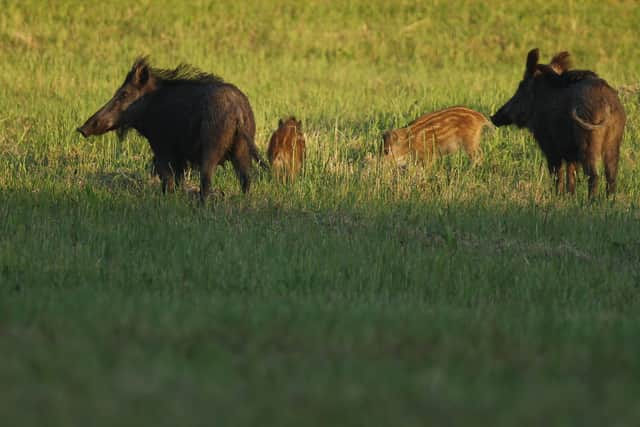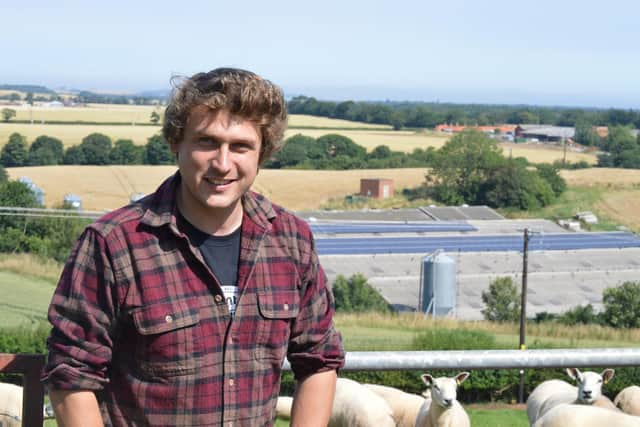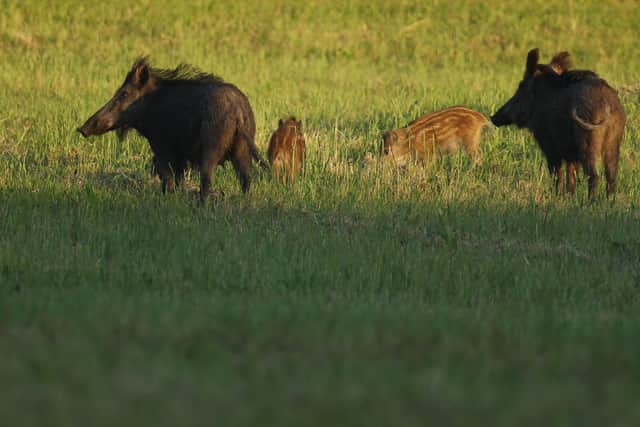Feral pigs Scotland: Scottish Government urged to act on rising population after decade of campaigning to control numbers
Calls have been renewed to introduce a policy to control feral pigs in Scotland as numbers are likely increasing rapidly, farmers and land managers have said.
The plea comes after more than a decade of campaign work and research to push ministers to act.
Advertisement
Hide AdAdvertisement
Hide AdIt is not known how many of the hogs, which are omnivores and a mix of domestic pigs and wild boar, are roaming around the country. Most have got there either by escaping farms or being illegally released. Reports show feral pigs can travel up to eight miles and are good swimmers, which raises concern over their ability to spread.


Their rooting behaviour can be beneficial to some woodland habitats, but it can also cause damage to farmland infrastructure and crops.
The pigs are also known to be territorial and there have been reports of them attacking and eating young livestock, and intimidating walkers. There is also the risk of them spreading diseases including African swine flu (ASF) to domesticated pigs on farms across the country.
Reports this week involved representatives of NatureScot and Forestry and Land Scotland (FLS) raising concerns over the likelihood feral pigs would rapidly increase in numbers.


But Lea MacNally, former manager and stalker on GlenQuoich estate in Upper Glengarry, in the Highlands, said he had been campaigning for a policy to be introduced to control numbers for more than a decade.
Speaking to The Scotsman, Mr MacNally, who is now retired, said: “I’ve been talking about this for at least 12 years, but to no avail. I’ve appeared twice on Landward, the farming programme, and written an article about the issue and all of a sudden NatureScot has realised there’s a potential of the pigs spreading and that they’re on the increase.”
FLS has said there are four well-established populations in Dumfries and Galloway, Glenmoriston, near Fort Augustus, and in Wester Ross. They are shy creatures and mainly nocturnal, and are often on the move which makes them difficult to count.


Mr MacNally said while there is no official estimate of how many there are, he said the population was very much on the rise, and has been for years, and they are spreading to the east of the country.
Advertisement
Hide AdAdvertisement
Hide Ad"If they get into the farmland in the east of the country, they will certainly be more productive there than in the more wild areas here where we live and that will add to the population explosion,” he said. "We need to try and get a handle on the population, which is going to be difficult.”
Steven McKenzie, head keeper at Aberchalder, said while it was rare, he had seen feral pigs attack young livestock in previous years. He said despite this year being quiet for sightings in the area, numbers were increasing.
"I’ve noticed the pigs do a circuit, so they could be with us a couple of months then we don’t see them again for a few months,” he said. "But as the numbers are increasing, they are coming around sooner and more often, and in bigger groups.


"At the moment we’re going through a quiet period, but a couple of years ago we were inundated on a nightly basis.”
There are no laws protecting feral pigs which means that landowners are able to protect their fields and livestock by removing pigs on their land.
A document produced for the Scottish Government by NatureScot recommended not letting the feral pig population numbers grow beyond their 2015 level, and outlined possible ways to control them. The report said relying on shooting alone is not the best way as the herd would disperse quite quickly. It recommended drop nets and corral traps, and that land managers should be trained to use these methods to help reduce the numbers.
However, a revisit of this study in 2022 pointed to feral pigs posing a huge risk to the spread of ASF which, according to National Farmers Union Scotland (NFUS) often sees mortality rates of 95-100 per cent.
While it is not in the UK, there is risk of it being brought in from meat imports, of which there are many from countries all over the world that have ASF present.
Advertisement
Hide AdAdvertisement
Hide AdJamie Wyllie, pig chairman at NFUS, said while the remit for border control and importation was not devolved to the Scottish Government, the issue of controlling feral pig numbers is.
"It goes without saying the numbers are increasing,” he said. “There needs to be a study to count numbers, and there needs to be a policy in place to control them from increasing beyond a sustainable number.
“The feral pig population is relatively small at the moment, but if it’s left to get bigger, it could become a serious problem. It cannot be ignored otherwise it will be too late. From a pig farmer’s perspective, I am really concerned about it.
"We have sent numerous letters to government to come with some sort of policy, but they seem to be ignoring it. The hard work of identifying the problem and coming up with solutions has already been done by NatureScot, but it needs actioned by Scottish Government as soon as possible before the problem becomes any worse.”
NFU Scotland and other leading farming organisations have previously written to ministers urging them to act.
A spokesperson at NatureScot said: “In recent decades, breeding populations of non-native feral pigs have become established in Scotland as a result of escapes or illegal releases. In Scotland, there are at least four separate breeding populations of feral pigs, located in Lochaber, Dumfries and Galloway and Ross-shire. We estimate the total population in Scotland may have reached the low thousands.
“Feral pigs breed prolifically and, if uncontrolled, their rooting behaviour can cause damage to the environment and to property. In particular, they pose a major threat to agricultural crops and pig farms and may undermine efforts to control future outbreaks of animal disease. If their numbers increase, they will also present a road collision risk.
“In Scotland, the primary responsibility for managing feral pigs lies with individual land managers. NatureScot has developed new best practice advice to help land managers to control feral pig populations safely and humanely.”
Advertisement
Hide AdAdvertisement
Hide AdA Scottish Government spokesperson said: “NatureScot is continuing to monitor the situation closely and have developed best practice advice to help land managers to control feral pig populations safely and humanely.”
Wild boar used to be a native species in Scotland before being eradicated in the 13th century because of over-hunting and habitat loss. It is believed there is no such thing as wild boar left in the UK, and the wild roaming hogs are feral pigs.
Comments
Want to join the conversation? Please or to comment on this article.